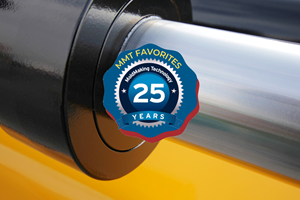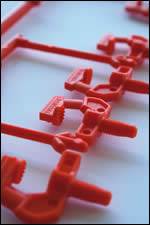How to Prevent Mold Inaccuracies
By keeping compressed air dry, moldmakers can prevent damage to critical equipment.
The process of producing molds generates large volumes of fine chips of metal that, if they aren't promptly removed, will lodge in precision equipment and make it impossible to meet close tolerances required. Tools used in machining centers and engravers to typically produce molds, are automatically moved into and out of the machine spindles during each machining cycle, as required to perform specific operations. Each time a tool change occurs, both the old and new tools are exposed to chips and other particles from the cutting bed. If any of these particles were to stick to the shank, the tool would not run true when inserted into the spindle. This might make it impossible for the machine to meet the level of precision required in producing molds.
Air Problems
To prevent this from happening, both the spindle and tool are blasted with compressed air each time a tool is changed. In some cases, the spindle and tool are cleaned automatically by the compressed air service installed in the machine while other machines' spindles are cleaned manually. The problem in many plants is that the air used to clean the spindles contains water that collects in the compressed air lines whenever humidity is high. In the hot summer months, the air line can look just like a garden hose. The result is that water is sprayed into the spindle along with the air, causing rust that creates the same accuracy problems as the chips that the air was designed to remove. Sometimes spindles need to be rebuilt or scrapped, and in other cases expensive repairs to the machine tool may be required.
The presence of water in air lines can cause other maintenance problems as well. Most plants use air motors in a wide range of tools such as pneumatic drills. If water contaminates the compressed air service, these motors may rust to the point that they stop functioning after just a few weeks of service. Rebuilding the motors typically takes about five hours and costs about $500 in parts.
Prevention
There are a number of potential solutions to this problem. Refrigerated dryers are relatively inexpensive to purchase, but consume a considerable amount of electricity and also require regular maintenance for the motors and other moving parts. On the other hand, compressed air dryers based on the membrane separation principle cost slightly more from an initial purchase standpoint, but have no moving parts and do not require any maintenance except for changing the filter every year. Dryers that use the membrane separation principle work like this:
- First, the compressed air passes through high efficiency coalescing filters. These filters remove oil and water droplets and particulate contamination.
- Then, the air moves into the dehydration membranes, which consist of bundles of hollow membrane fibers, each permeable only to water vapor.
- As the compressed air passes through the center of these fibers, water vapor permeates the walls of the fiber, and dry air exits from the other end.
- A small portion of the dry air is redirected along the length of the membrane fiber to carry away the moisture-laden air that surrounds it.
- The remainder of the dry air is piped to the application.
These dryers are designed to operate continuously 24/7. An electrical supply is not required to use these dryers. The only maintenance required is changing the prefilter cartridge a maximum of once a year. The time required to change the prefilter cartridge is approximately five minutes. For these reasons, most moldmakers' calculations show that membrane separation costs considerably less over the long run.
Related Content
The Benefits of Hand Scraping
Accuracy and flatness are two benefits of hand scraping that help improve machine loop stiffness, workpiece surface finish and component geometry.
Read MoreHands-on Workshop Teaches Mold Maintenance Process
Intensive workshop teaches the process of mold maintenance to help put an end to the firefighting culture of many toolrooms.
Read MoreHow to Correctly Size a Hydraulic Cylinder
This week Randy shares steps for correctly sizing a hydraulic cylinder on a mold.
Read MoreExploring ISO 9000 - Part 16 Control of Quality Records
A Series of International Standards for Quality Management and Quality Assurance. We begin 2022 with a review of Clause 4.16 Control of Quality Records.
Read MoreRead Next
Multi-Cavity Mold Issues Solved with Melt Rotation Process
Toolroom supervisor shares his experience with a rheological control solution to some obvious and some not-so-obvious challenges with product and color variations in a multi-cavity mold.
Read MoreHow to Use Continuing Education to Remain Competitive in Moldmaking
Continued training helps moldmakers make tooling decisions and properly use the latest cutting tool to efficiently machine high-quality molds.
Read MoreHow to Use Strategic Planning Tools, Data to Manage the Human Side of Business
Q&A with Marion Wells, MMT EAB member and founder of Human Asset Management.
Read More_970x90 4.png;maxWidth=970;quality=90)










.jpg;maxWidth=300;quality=90)










